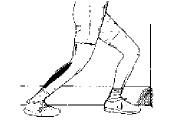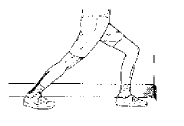Dr. MJ Bazos MD,
Patient Handout
Plantar Fasciitis: A
Common Cause of Heel Pain
What is the plantar fascia?
The plantar fascia is a band of tissue, much
like a tendon, on the bottom of your foot. It starts at your heel and goes along
the bottom of your foot. It attaches to each one of the bones that form the ball
of your foot. The plantar fascia works like a rubber band between the heel and
the ball of your foot to form the arch of your foot. If the band is short,
you'll have a high arch and if it's long, you'll have a low arch, or what some
people call flatfeet. A pad of fat in your heel covers the plantar fascia to
help absorb the shock of walking. Damage to the plantar fascia can be a cause of
heel pain.
What causes the heel pain?
As a person gets older, the plantar fascia
becomes less like a rubber band and more like a rope that doesn't stretch very
well. The fat pad on the heel becomes thinner and can't absorb as much of the
shock caused by walking. The extra shock damages the plantar fascia. Damage to
the plantar fascia may cause it to swell, tear or bruise. You may notice a
bruise on your heel or that your heel is swollen.
How will my doctor know if the pain
I have is caused by plantar fasciitis?
Your doctor will ask you about the kind of pain
you're having, when it occurs and how long you've had it. If you have pain in
your heel when you stand up for the first time in the morning, you may have
plantar fasciitis. Most people with plantar fasciitis say the pain is like a
knife or a pin sticking into the bottom of the foot. After you've been standing
for a while, the pain becomes more like a dull ache. If you sit down for any
length of time, the sharp pain will come back when you stand up again to walk.
What can I do about the heel pain?
If you walk or run a lot, cut back a little. You
probably won't need to stop walking or running altogether.
If you have either flatfeet or a high arch, ask
your doctor about using orthotics, or inserts for your shoes. Orthotics are arch
supports. You will need to be fitted for them.
If you are overweight, losing weight can help
lessen your heel pain. If your job involves standing on a hard floor or standing
in one spot for long periods, place some type of padding on the floor where you
stand.
Are there any exercises that will
help?
Stretching exercises for your foot are
important. Do the stretches shown here at least twice a day. Repeat each stretch
10 to 15 times. Don't bounce when you stretch. Hold each stretch for at least 10
to 15 seconds.
You can also strengthen your leg muscles by
standing on the ball of your foot at the edge of a step and raising up as high
as possible on your toes. Relax between toe raises and let your heel fall a
little lower than the edge of the step.
It's also helpful to strengthen the foot by
grabbing a towel with your toes as if you are going to pick up the towel with
your foot. Repeat this exercise several times a day.
Will any medicine help?
Aspirin, acetaminophen (one brand name:
Tylenol), naproxen (brand name: Aleve), ketoprofen (brand name: Ordis), or
ibuprofen (brand names: Advil, Motrin, Nuprin) can ease the heel pain, but talk
to your doctor before you take any medicine.
What if my foot still hurts after
doing the exercises, using the arch supports and taking other measures?
If stretching, arch supports, medicine and
exercises don't help, your doctor can suggest other treatments. You may need to
wear splints on your foot at night, tape your foot or have injections of
corticosteroids into the plantar fascia. In a very few cases, surgery is needed.
You and your doctor can decide which treatment is best for you.





